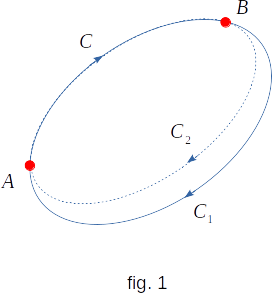From the Electrostatics
76. Potential difference
The electrostatic field has one very important property. This property refers to the work performed by the forces of the electric field while moving an electric charge.
The work is always performed when the force acts on the moving body, (\(W = Fd\)). In some cases, when moving a body between points A and B, the work depends on the shape of the trajectory along which the movement takes place. Thus, it is quite clear that the work of moving the cabinet from one corner of the room to another will be much less if you move the cabinet in a straight line rather than zigzagging from wall to wall.
In other cases, however, the work of moving a body from A to B is completely independent of the shape of the body trajectory. This is how the electrostatic field forces (and in general, the forces that depend only on the coordinates) work when moving a charge in this field. On the closed path the work in the electrostatic field is equal to zero (fig. 1). Fields with such property are called potential; the Earth's gravitational field in particular is potential.

It is not difficult to understand why an electrostatic field is potential. If the positive, for example, work on the movement of the charge from A to B (along the curve of ACB, fig. 1) is not equal to the value of the negative work when moving in the opposite direction on any other path (\(BC_1A\), \(BC_2A\), etc.), it would be possible to build a perpetual motion. After all, when the charge moves on a closed track with the charges creating the field, nothing happens. They both stood still and will stand still. Therefore for one turn it would be possible to receive useful work which can be easily increased in any number of times by repeated duplication of the passed way. But it is impossible.
So, if the field is potentially, the position of any two points A and B in this field clearly defines the work of moving an electric charge between these points. The magnitude equal to the work of moving an one unit positive charge is called a potential difference or voltage between points A and B. Knowing the voltage in the socket means that we know the work that an electric field can do when moving an one unit charge from one contact of the socket to another along any path and, therefore, along any electric circuit. If the voltage is \(110 \,V\), the movement of one coulomb will be accompanied by the work of \(110 \,J\).